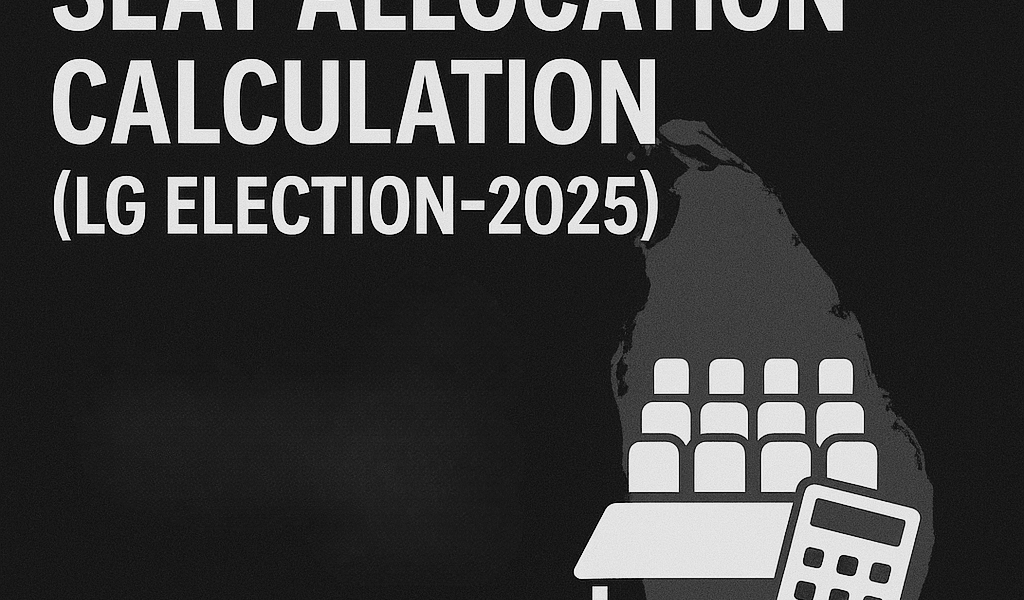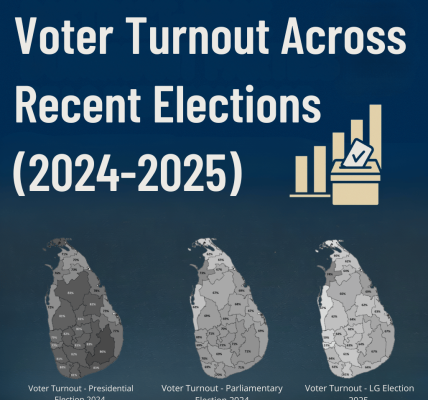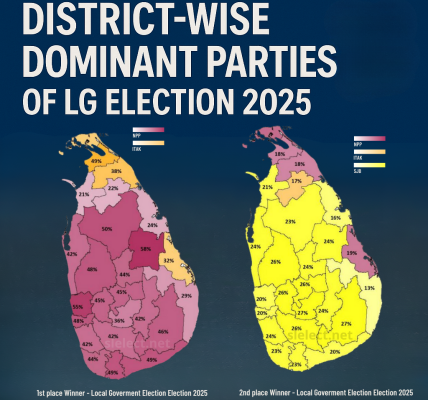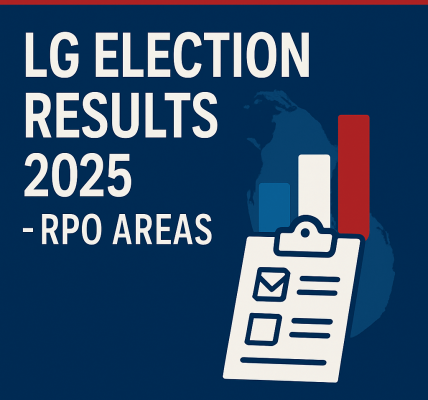- Homepage
- LG Election 2025
- District-wise Seat Allocation Calculation (LG Election-2025)
District-wise Seat Allocation Calculation (LG Election-2025)
District-wise seat allocation calculation
The 1978 Constitution introduced a radical departure to the previously existing electoral system and electoral districts. This system, commonly described as the “First-Past-the-Post” (FPP) system, was changed in to a system of Proportional Representation (PR) in respect of 22 electoral districts.
Sri Lanka has 25 districts and 22 electoral districts. Out of these, twenty of them have the same boundaries as their administrative districts. The two exceptions are Jaffna (which covers the administrative districts of Jaffna and Kilinochchi) and Vanni (which covers the administrative districts of Mannar, Mullaitivu and Vavuniya).
According to the 14 Amendment in 1988, increased the number of members of parliament are 225. Under the current system, 196 members are elected from 22 multi-member electoral district based on proportional representation method. The remaining 29 seats known as National List are allocated to contestant parties and independent groups based on their proportion of the national vote.
Total number of Members of Parliament for each electoral district is specified by the Commissioner of elections before each Parliamentary election. The specified list for 2024 is as below.
| No.of Districts | No.of seats (Total 196) |
|---|---|
| Colombo | 18 |
| Gampaha | 19 |
| Kalutara | 11 |
| Kandy | 12 |
| Matale | 5 |
| Nuwara Eliya | 8 |
| Galle | 9 |
| Matara | 7 |
| Hambantota | 7 |
| Jaffna | 6 |
| Vanni | 6 |
| Batticaloa | 5 |
| Ampara | 7 |
| Trincomalee | 4 |
| Kurunegala | 15 |
| Puttalam | 8 |
| Anuradhapura | 9 |
| Polonnaruwa | 5 |
| Badulla | 9 |
| Monaragala | 6 |
| Ratnapura | 11 |
| Kegalle | 9 |
Table 1: Number of seats allocated for each district
As 14 Amendment in 1988 says, in Parliamentary elections, every voter can vote for one party and select up to three preferred candidates from the chosen party. Every voter gets one vote even if they are listed in multiple districts.
Seat Allocation Method
- The party with the highest number of votes gets one candidate elected, this is called as the bonus seat.
- A party or group that polls less than 5% of total district vote is disqualified to have any seat. Their votes are subtracted from the total votes.
- After removing disqualified votes, remaining total votes are divided by the number of seats in each districts minus one (total seats- bonus seat). This is called the “quota”of votes needed to win a seat.
- Initially, each party’s total valid votes are divided by the quota determine how many seats they get.
- If there are seats left after the initial allocation, remaining seats are distributed based on the remainders.
- Remaining seats are given to the parties with the highest remainders, one at a time, until the seats are filled.
Example:
Let’s consider Kandy district.
Parties who received above 5% of votes and the amount of votes they received are as follows.
| Party | Votes Received | Vote Percentage |
|---|---|---|
| NPP | 323957 | 0.4458 |
| SJB | 189246 | 0.2604 |
| SLPP | 48270 | 0.0664 |
| UNP | 37192 | 0.0512 |
| Total | 598665 |
Table 2: Parties who received above 5% votes in Kandy
Allocated number of seats for Kandy district is 12.
Since NPP received the highest number of votes, they get the bonus seat.
Remaining 11 seats must be distributed among the 4 eligible parties.
Initially, the quota should be calculated.
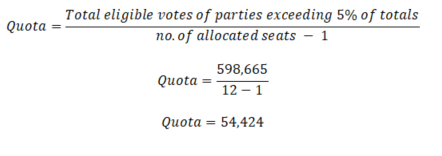
To calculate the number of seats each party receives, total number of votes they received in Kandy district should be divided by quota.
| Party | No.of Votes | Method | No.of Seats |
|---|---|---|---|
| NPP | 323957 | 323,957 / 54,424 | 5.952 |
| SJB | 189246 | 189,246 / 54,424 | 3.477 |
| SLPP | 48270 | 48,270 / 54,424 | 0.887 |
| UNP | 37192 | 37,192 / 54,424 | 0.683 |
Table 3: Seat Calculation Method
- Here, whole number and remainder are considered separately.
- According to Table 3, NPP currently has 5+1 (bonus seat)=6 seats and SJB has 3 seats.
- Kandy has 12 allocated seats.
- These seats are distributed after considering the remainder, parties with the highest remainders get the remaining seats.
- Accordingly, 3 remaining seats are allocated to NPP, SLPP, UNP.
Example cntd.
| Party | Bonus Seat | Regular Seats | Seats from Remainder | Total Seats |
|---|---|---|---|---|
| NPP | 1 | 5 | 1 | 7 |
| SJB | 3 | 3 | ||
| SLPP | 1 | 1 | ||
| UNP | 1 | 1 |
National List Calculation
After the 196 members of Parliament have been elected from the electoral districts, the remaining 29 seats will be allocated to the groups polling the most votes. This apportionment is based on the proportion of votes each party or group received.
Each party or group that contests the General Election must submit a list of qualified candidates during the nomination period. These candidates and those nominated for each district failing to get elected are eligible to fill the National List seats their party or group is entitled to.
Formula to calculate National List seat winners is as follows,

However, if a party’s proportion of the national vote results in less than one seat (e.g., 0.5 seats), that party does not receive a national list seat.
